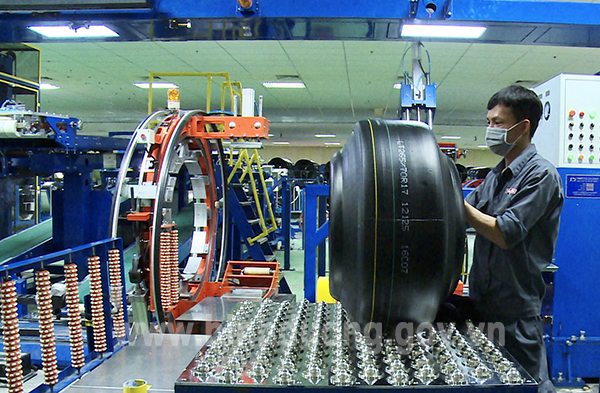To promote green, digital economy and sustainable development
In the stage of industrialization and modernization, Binh Duong has been and is focusing on developing the digital economy, green economy, and promoting sustainable growth.
Digital transformation as a turning key
Mr. Nguyen Loc Ha, Member of the Provincial Party Committee's Standing Committee, Vice Chairman of the Provincial People's Committee, said that at the present stage, Binh Duong is focusing on completing the provincial planning project, outlining directions for breakthrough development in the coming time. Binh Duong identifies one of the decisive foundations as innovation, developing green economy, digital economy.
The Standing Committee of the Binh Duong Provincial Party Committee issued a resolution on digital transformation by 2025, aiming towards 2030. The resolution clearly defines digital transformation as the "key" to actively participate in the Fourth Industrial Revolution. Promote digital transformation with key pillars of digital government, digital economy, digital society, and digital citizens to change the overall and comprehensive management and operation of effective, efficient, transparent government; change the production and business activities of enterprises, promote innovation, increase labor productivity, and create growth momentum. Key sectors and fields implement digital transformation towards optimization, smartification, contributing to achieving the goal "Binh Duong sustainable development towards a smart, civilized, modern urban area".

Binh Duong is focusing on attracting high-quality investment, developing a green economy, and enhancing the value of various sectors. In the photo: Production at Hung Hai Thinh Joint Stock Company, Tam Lap Industrial Cluster, Phu Giao district
Binh Duong has now become a promising destination for human resources. After more than 27 years of construction and development, the population of Binh Duong has increased from 661,200 people to 2.88 million people in 2023. The province has developed a strong university system, ranking third in quantity after Hanoi and Ho Chi Minh City. In particular, Binh Duong has made significant progress in social housing to ensure accommodation for workers, becoming a bright spot for the whole country.
The hiccup to overcome
According to the provincial planning draft until 2030, vision until 2050, Binh Duong will become a modern urban, industrial, and service area, with regional and international stature, being one of the leading forces driving the national economic development. However, the province is facing some limitations and existing issues in the development process.
Theo GS-TS Tran Tho Dat, Member of the Central Theoretical Council, Member of the Government's Economic Advisory Board, Chairman of the Professor Council of the Economics Department, alongside the achievements that Binh Duong has achieved over the years, the recent investment capital of the province has decreased in speed compared to other localities. On the other hand, the province does not have a chain of product links or a cluster of industry links in the area. Infrastructure projects connecting the region are still in the waiting period for completion, and services are not commensurate with industry and urban areas. Private economic areas have not yet developed strongly. “To meet the needs of industrial and service development in Binh Duong, which mainly relies on out-of-province labor, most of whom have low skills. In order to enhance the effectiveness of socio-economic development, Binh Duong needs to adjust its investment attraction strategy in line with human resource development,” said Professor Tran Tho Dat. According to Dr. Tran Thi Lan Huong, National Economics University, after decades of growth through old industrial sectors, capital and labor exploitation, Binh Duong needs a source of motivation for the next growth phase. The key to the next growth phase of Binh Duong is the growth in numbers and green growth. However, compared to provinces with similar income, Binh Duong's position in terms of digital economy and digital transformation is still very low, and this is the bottleneck that Binh Duong needs to overcome to move towards a new growth state.
Specifically, the indices on the provincial digital transformation ranking, although improved, still rank in the middle, not commensurate with the stature of a key province like Binh Duong. According to Ms. Tran Thi Lan Huong, Binh Duong, despite always being at the top nationwide in terms of digital awareness and digital infrastructure indices, reflects the attention of the provincial government and the investment of the whole society in digital capacity. However, the spreadability is very limited when the two key indicators evaluating the digital transformation results, which are the economic index and the social index of Binh Duong, are very low.
Mrs. Tran Thi Lan Huong added that in the context of Vietnam's commitment to achieving net-zero emissions by 2050, industrial centers in Binh Duong need to develop in a sustainable and green direction through restructuring industrial sectors, especially the processing industry group. This migration process not only helps Binh Duong meet the "green" goal but also the "digital" goal, with a low proportion of the digital economy/GRDP, Binh Duong needs to take the high-tech industry as the core to promote the industrialization process in the next stage. Industries and sectors with low productivity, low energy efficiency, and high emissions need policies to minimize or be included in the conditional investment list. High-productivity sectors with low emissions such as the beverage, pharmaceutical, chemical, and herbal medicine industries, especially information technology and electronics, need to be encouraged to develop.
“Through the industrial restructuring solutions group, infrastructure connectivity, administrative procedure digitization, and human resource training, Binh Duong can increase its capacity for innovation, greenify industries, and move towards a new period of strong and sustainable growth," said Mrs. Tran Thi Lan Huong.
| Binh Duong strives to achieve a digital economy accounting for 30% of GRDP by 2030, with each sector and field having a minimum digital economy share of 20%. The proportion of e-commerce in total retail sales is targeted to exceed 20%. The percentage of businesses using electronic contract platforms is expected to reach 100%, while the percentage of small and medium-sized enterprises using digital platforms is targeted to be over 70%. |
Reported by Phuong Le – Translated by Vi Bao

